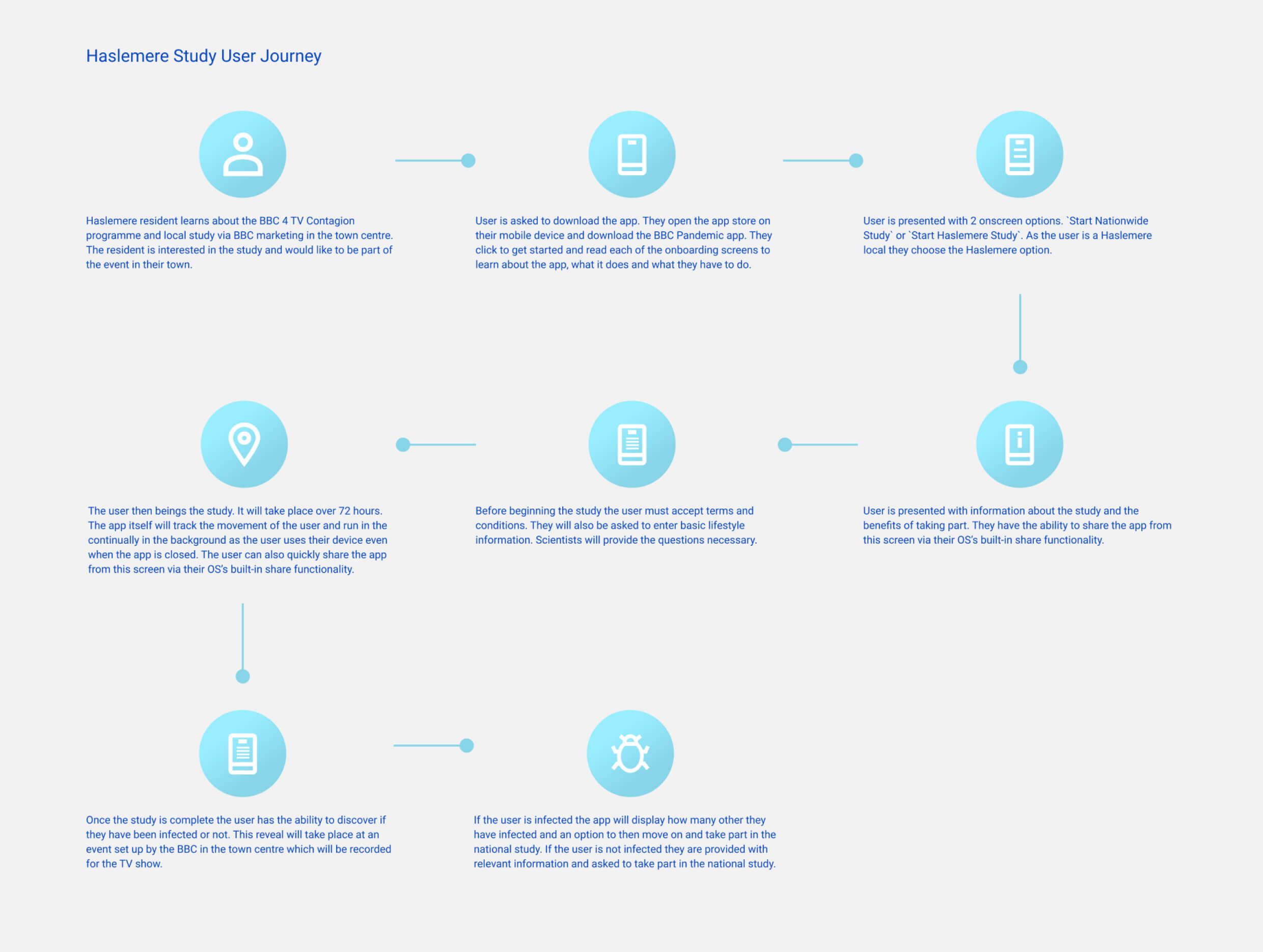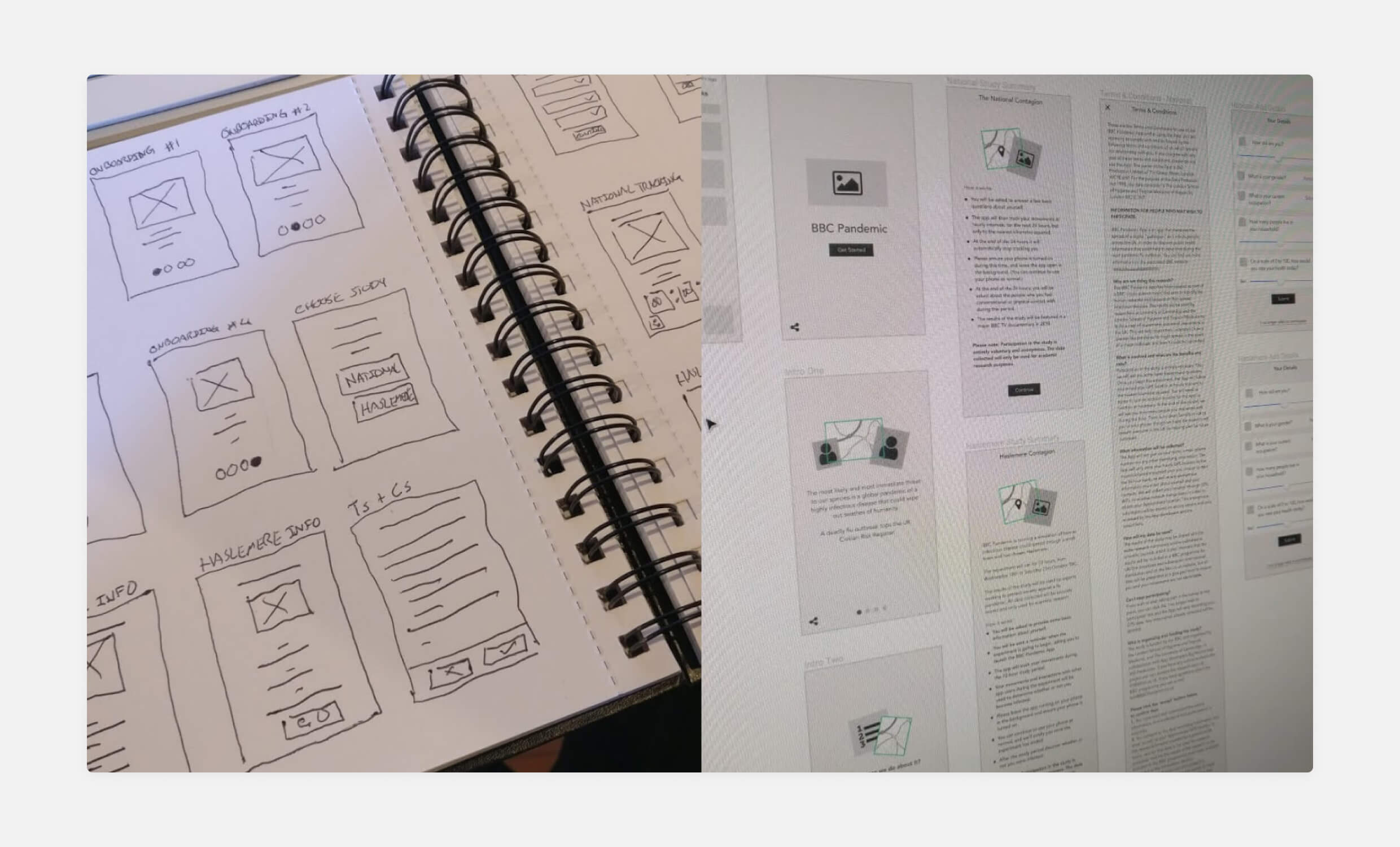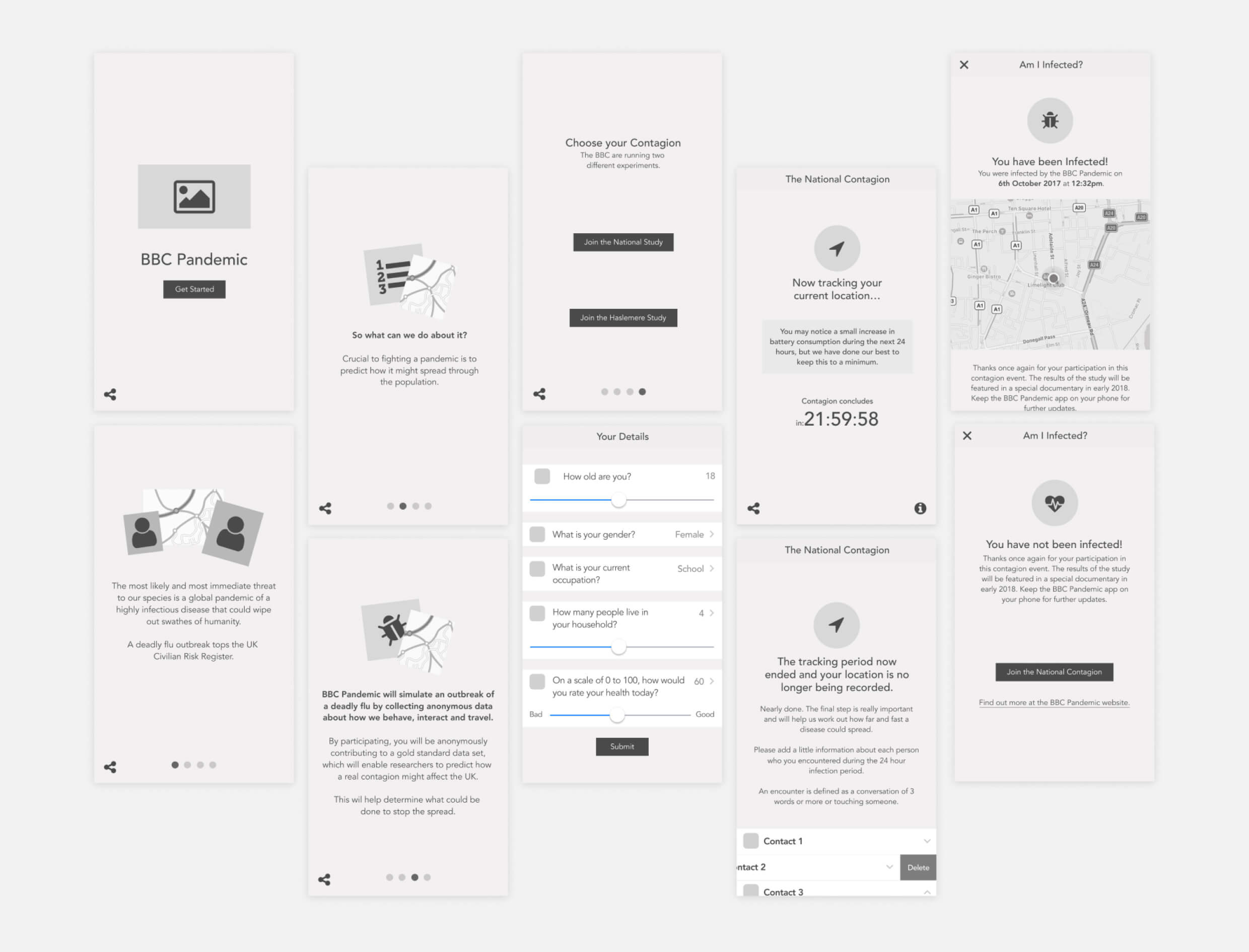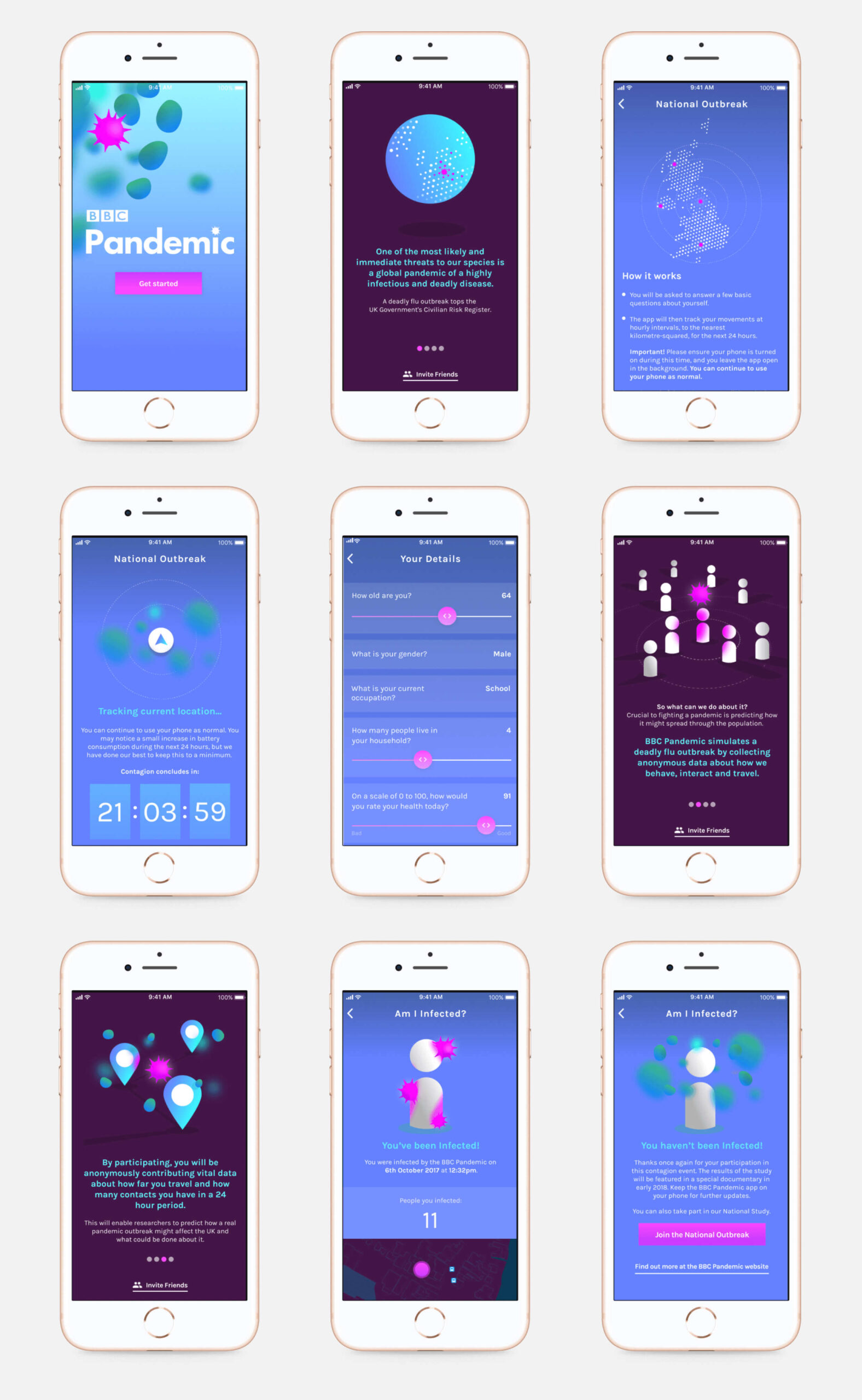BBC Pandemic Application Design
In 2018, I served as the Lead UX/UI Designer for BBC Pandemic, a groundbreaking citizen-science application developed in collaboration with BBC Four, 360 Productions, and scientists from the University of Cambridge and the London School of Hygiene & Tropical Medicine.
Over four months, our team designed and delivered a mobile experience that tracked users’ real-world movements and self-reported contacts—ultimately helping researchers model how a flu virus could spread throughout the United Kingdom.
By launch, the app exceeded expectations, engaging over 100,000 participants, ranking #1 in the Medical category on both the iOS and Google Play stores, and securing widespread media coverage across BBC One, BBC Four, and national newspapers.
Role
- Research Analysis
- User Journey Design
- Wireframe Design
- UI Design
- App QA
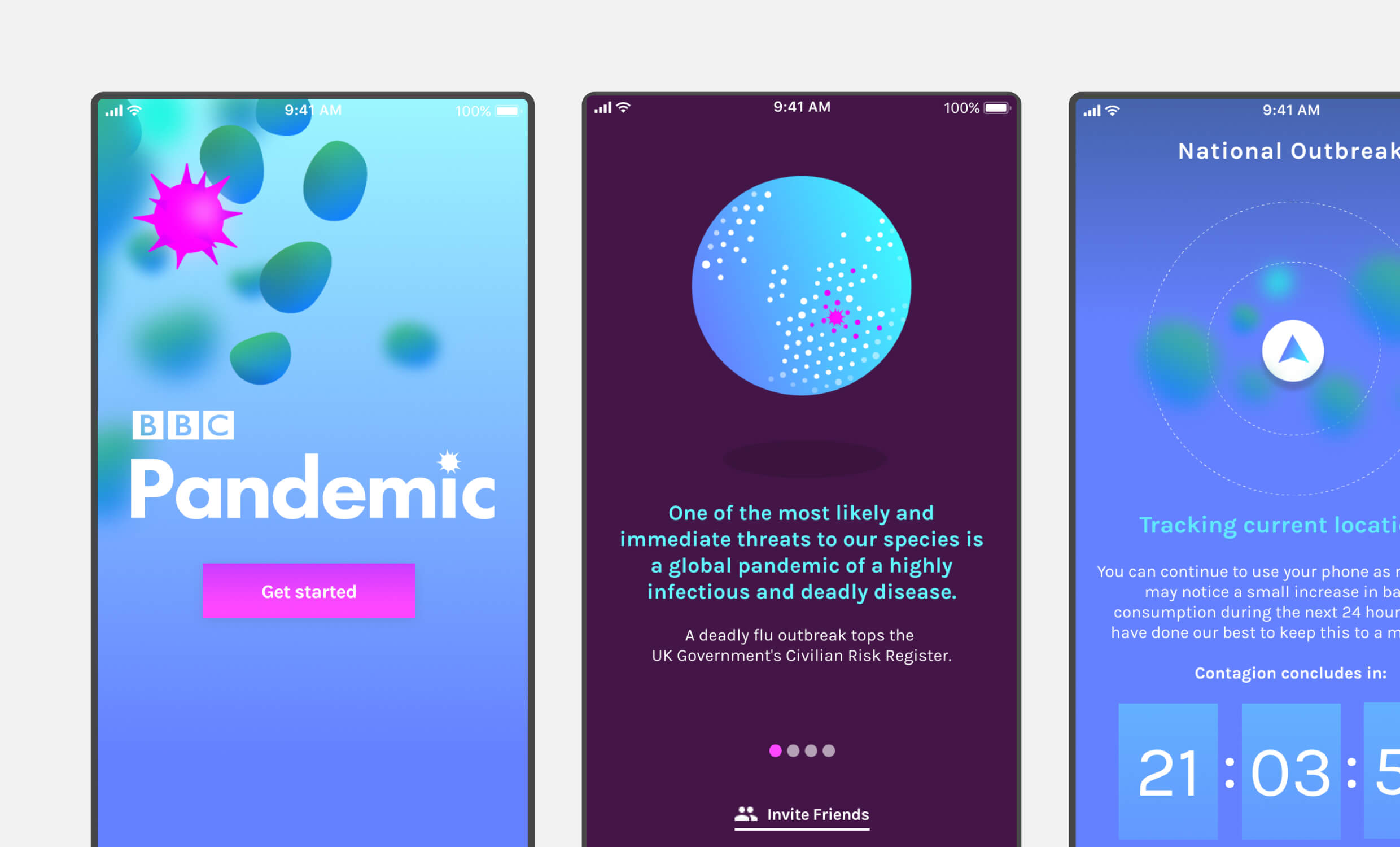
Why It Mattered
Pandemic flu is among the UK government’s top public safety concerns, yet real-world data on how quickly it spreads is limited. By recruiting tens of thousands of citizens to log their movements and interactions, the BBC Pandemic experiment provided a groundbreaking dataset for epidemiologists. The resulting insights fed directly into a BBC Four documentary—Contagion! The BBC Four Pandemic—presented by Dr. Hannah Fry, underscoring how design can empower large-scale, real-time scientific research.
Background & The Challenge
Early in the discovery phase, we partnered with scientists from the University of Cambridge and the London School of Hygiene & Tropical Medicine to understand the data needs: precise hourly location logs, self-reported contacts, and demographic info. Our objective was clear: get as many participants as possible to provide accurate data over a 24-hour (or multi-day) period.
However, we faced several key hurdles:
- User Trust & Privacy: We had to be transparent about why we were collecting movement and contact data—and how it would be stored—to ensure broad participation.
- Wide Demographic Range: The app needed to be accessible to all adult age groups and tech-savviness levels across the UK.
- Scientific Rigor: The data inputs had to align with rigorous academic standards, leaving us little room for UI shortcuts that might simplify data entry but risked accuracy.
- Tight Timelines: BBC Four’s broadcast schedule dictated that core features and final designs be delivered within four months, leaving little margin for delays.
Defining the User Experience
We began by mapping out two user pathways: the National Study (24-hour tracking plus contact-logging) and a more localised Haslemere Study (extended tracking in one town). While the scientists required comprehensive data logs, we had to ensure users would complete these steps willingly.
- Onboarding & Consent: To address privacy concerns, we placed straightforward terms and conditions during sign-up. This section explained data usage in layman’s terms and offered clear opt-in steps.
- Guided User Journeys: Instead of dropping users directly into a complicated process, we introduced short prompts and explanations that explained why each step mattered.
Wireframing & Prototyping
After initial whiteboard sketches, I created Figma wireframes to outline the core screens—registration, consent forms, location tracking permissions, and final “infection status” results.
- Internal Testing: We ran quick InVision prototypes with our team, scientists, and friendly user groups to get feedback on clarity, navigation, and UI flow.
- Iterative Changes: Early testers emphasised the importance of seeing how their data contributed to the study, so we added progress indicators and explanatory tooltips throughout.
UI Design & Branding
While we followed the BBC’s overarching brand guidelines (colour usage, font options), we had freedom to design custom interface elements that felt welcoming and intuitive for large-scale public use.
- Focus on Accessibility: We emphasised legible typography, high-contrast form fields, and straightforward button labels—anticipating many users might not be familiar with app-based data collection.
- iOS & Android Nuances: Though the core design remained the same, small adjustments like native header styles and navigation patterns ensured a consistent yet platform-appropriate user experience.
Key Constraints
Data Collection & User Concerns
The scientists needed detailed, hourly location logs—often a sticking point for users. To reduce skepticism, the app spelled out how GPS data would be anonymised and aggregated before being shared. We also optimised background tracking to minimise battery drain.
QA & Development Coordination
Because of our limited timeline, we partnered with an external development team who shipped nightly test builds. My QA responsibilities included checking user flows, data collection integrity, and edge-case scenarios (like turning GPS on/off frequently). Issues were tracked in spreadsheets and Jira tickets, ensuring a quick feedback loop.
Engagement & Retention
For the experiment’s success, participants had to keep the app running during the entire study window. Our solution involved timely push notifications reminding users to finalise their contact lists or check in daily, with minimal intrusiveness.
Outcome & Impact
A few weeks after launch, over 50,000 users had completed their studies—shattering initial targets. The app ranked #1 in the Medical category on both the UK App Store and Google Play Store. Television features on BBC One’s The One Show and the BBC Four documentary itself spurred even more participation; within six months, nearly 100,000 people nationwide joined, making it one of the most significant citizen-science datasets ever compiled on flu-spread modelling.
Media coverage included The Guardian, The Telegraph, Huffington Post, and The Daily Express. The app was nominated for a DANI award and later named “App of the Year” at the Digital DNA awards—recognition of not just the scientific innovation, but the importance of user-focused design in a large-scale data project.
Lessons Learned & Reflections
Designing the BBC Pandemic app highlighted the balancing act between scientific precision and accessible user experience:
- Trust Is Key: Clear communication around why we collect sensitive data can transform users from wary onlookers into enthusiastic contributors.
- Accessibility Pays Off: By simplifying forms and emphasising user onboarding, we reached a wide audience—from tech-savvy urbanites to older rural participants—thereby amplifying the dataset’s overall value.
- Tight Timelines Spur Agile Mindsets: With only four months, we relied heavily on iterative testing, daily syncs, and rapid prototyping—an approach that kept us aligned and delivered on schedule.
- Potential for Greater User Engagement: Given more time, we would have further refined the “infection status” reveal and provided deeper post-study feedback, keeping participants more engaged after data submission.
Nonetheless, the project succeeded in collecting vital information for researchers modelling future outbreaks—showcasing how thoughtful UX/UI can drive widespread public adoption of a complex scientific tool.
Tools & Collaboration
- Figma for wireframes and interactive prototypes
- InVision for quick stakeholder reviews and user testing
- Spreadsheets + Jira for QA documentation and development handoffs
- Daily Stand-ups with an external dev team to resolve issues fast
Looking Ahead
The BBC Pandemic app demonstrates the power of combining human-centred design with large-scale data collection. The resulting dataset is now available to the scientific community, fueling ongoing research in epidemiology and public health. For me, this project was a testament to how a well-crafted user experience can spur genuine public engagement—even around sensitive topics like real-time location tracking—and ultimately help shape policy, planning, and national preparedness strategies. If you’d like to learn more about my process or how these insights can be applied to other large-scale data initiatives, feel free to get in touch.



